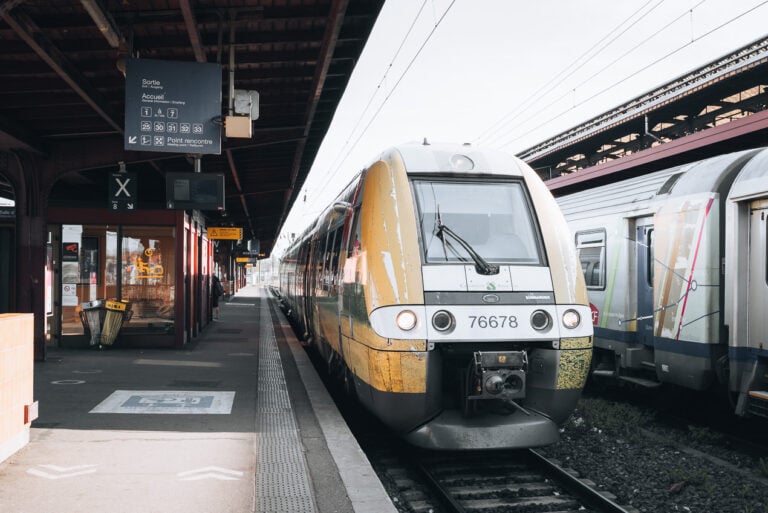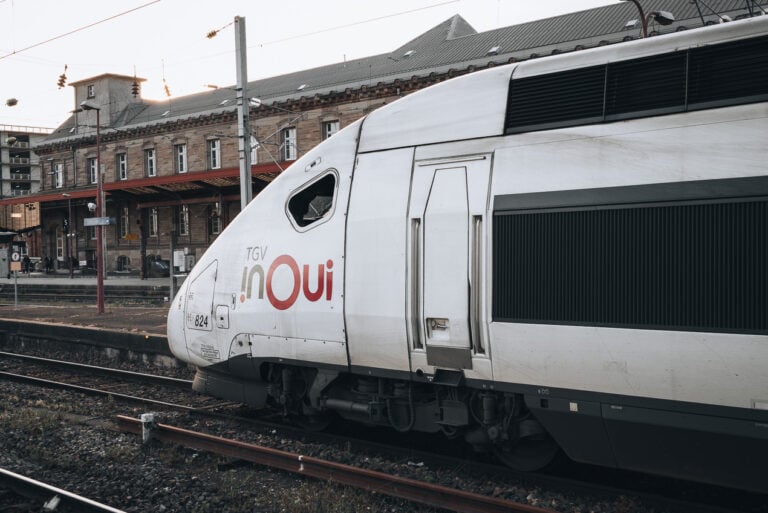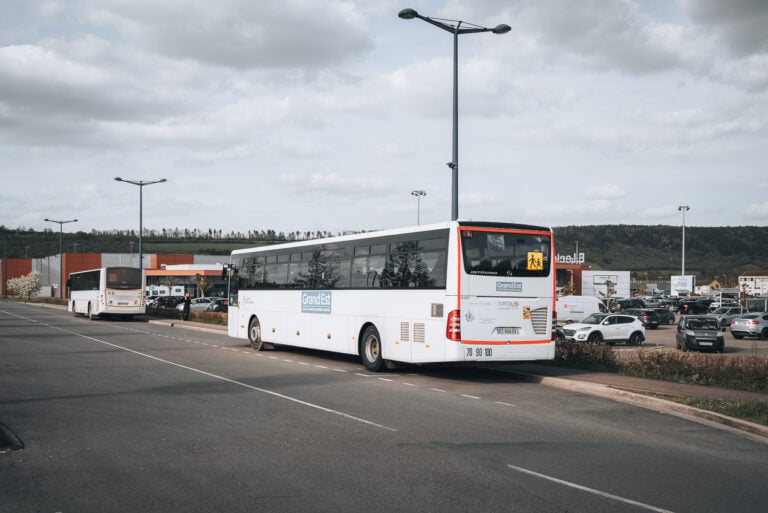I grew up in the United States and was raised with the idea that a car was a necessity for getting around. But when I moved to France, I decided to try a public transportation-based lifestyle.
I quickly realized that not only is it possible, but it’s also more convenient, cheaper, and better for the environment.
It’s been eight years now. I still live in France and travel around the country without a car.
I’ve used trains, buses, bikes, and even walked.
In this guide, I will share my tips and tricks for getting around France without a car.

Please note: This post contains affiliate links, meaning I may earn a commission if you make a purchase by clicking on a link (at no extra cost to you). Privacy Policy.
1. By Train


France’s train network is one of the best in the world, and it’s a fantastic option for getting around. It’s the main mode of transport I use to travel between cities.
The national railway company is run and operated by SNCF, and it offers several options for train travel.
Here’s a quick breakdown of what you need to know:
- TGV: For long distances, the high-speed TGV trains are a great choice. They go between major cities like Paris and Lyon in just a few hours. Book your tickets early to save money, as prices tend to rise closer to your travel date.
- OUIGO: For budget travelers, OUIGO offers low-cost train tickets to destinations such as Paris, Lyon, and Marseille. The cost is usually lower than TGV trains, but for the same distance, it can take twice as long.
- TER (Transport Express Régional): For shorter trips or traveling within a region, TER trains are your go-to option. They connect places, like Strasbourg and Colmar in Alsace or Beaune and Dijon in Burgundy. The TER system is affordable, frequent, and covers most regions. There are no seat reservations, and you can buy your tickets the same day you plan to travel.
To book your tickets, I recommend SNCF-Connect. It’s the official website and, usually, offers the best price.
If you prefer third-party options, Omio is my go-to platform.
2. By Bus

While it is rare, some towns don’t have a train station. In these situations, buses are the next best option.
They’re an inexpensive and, for the most part, reliable way to visit smaller towns and rural areas.
Helpful Tip: For long-distance travel, companies like FlixBus and BlaBlaCar offer budget-friendly connections between cities in France.
Each region has its own network, and schedules are typically available online or at tourist offices. The only downside is their availability. Services are usually less frequent on the weekends and holidays.
Below, I’ve listed the apps and websites you can use for each region:
- Grand Est
- Auvergne-Rhône-Alpes
- Provence-Alpes-Côte d’Azur
- Nouvelle-Aquitaine
- Normandy
- Occitania
- Bourgogne-Franche-Comté
- Bretagne
- Centre-Val de Loire
- Hauts-de-France
- Pays de la Loire
Helpful Tip: For most public buses, tickets need to be purchased on the bus with cash (most don’t accept credit or debit cards).
Then, there are tourist buses, and I’m not talking about the ones that can hold hundreds of people.
There are many smaller buses, like the Kutzig bus in Alsace, that stop at towns without a train station. They are faster than the public buses and avoid all the local stops.
3. By Intercity Public Transport

Most big cities in France have either trams or metros (and in some cases both). These are usually the most efficient and convenient way to get around within a city.
In Paris, for example, the metro system has 14 lines that cover all parts of the city and its outskirts. It can take you from one side of the city to the other in less than an hour.
Other cities, like Strasbourg, have tramways that make it easy to navigate and explore the city.
You can purchase individual tickets or multi-day passes at the stations or on the city’s transport app.
Below, I’ve included the public transportation websites/apps for the major cities in France:
- Paris
- Lyon
- Strasbourg
- Marseille
- Montpellier
- Lille
- Toulouse
- Bordeaux
- Nantes
- Dijon
- Nantes
- Aix-en-Provence
- Nice
4. By Bike

In general, France is a very bike-friendly country.
Many cities are working on building bike lanes and offering bike-sharing programs.
There are also long-distance cycling routes around the country, such as the Alsace Wine Route and the EuroVelo 15.
So far, I’ve rented bikes in Strasbourg, Paris, and Dijon, and I can honestly say it’s one of the best ways to get around. The bikes are usually well-maintained and affordable, and, in many cities, you can even rent electric bikes.
Helpful Tip: In most cases, I use the local metro or tram to get around, and I rent a bike when I want to visit something outside the center.
Below are the bike sharing websites for the major cities in France:
- Paris
- Strasbourg
- Lyon
- Bordeaux
- Lille
- Dijon
- Marseille
- Grenoble
- Toulouse
- Nantes
- Reims
- Aix-en-Provence
- Montpellier
Helpful Tip: You can also bring your rented bike on the train. TER regional trains often have dedicated bike spaces, and some TGV trains accommodate bikes if you reserve in advance.
Conclusion
I’ve spent eight years traveling around France, and most of it I did without a car. There are so many public transportation options that are efficient and affordable.
My go-to is the train. For long distances, taking a TGV train is faster than driving, and once I’m at my destination, I use the regional TER trains or intercity transport.
Now that you know how to visit this beautiful country without a car, why not check out some other car-free activities, such as those in Alsace?
Read More Articles
I hope you enjoyed my post and found it helpful. Here are some other articles that I think you might enjoy.
- The Perfect Paris to Amiens Day Trip Itinerary
- The Perfect Day Trip to Strasbourg from Paris (by a Local)
- Paris to Dunkirk Day Trip: The Perfect Itinerary
- 6 Best Ways to Get from Colmar to Eguisheim